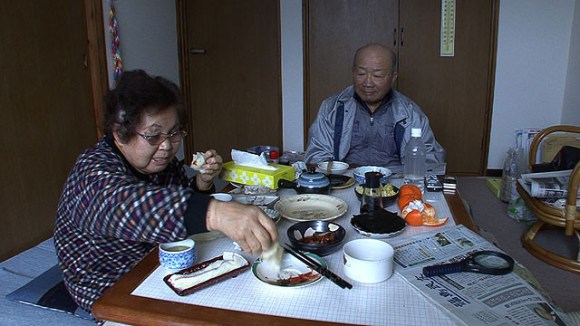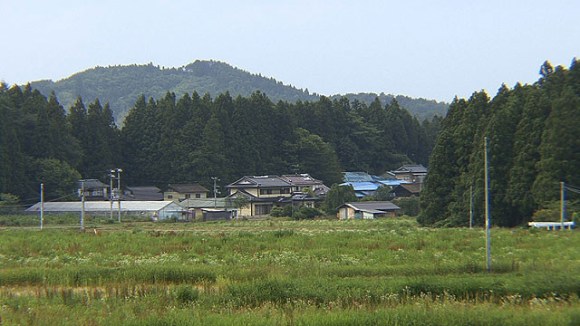
Two years after Japan’s great earthquake and the Daiichi nuclear diaster comes a documentary that tells of the citizens who still can’t return home to Iitate Village in Fukushima due to the high levels of radiation.
Over at our sister site, Pouch, film critic Kaori Saito was given the opportunity to check out the film production of “Iitate Village, the Problem of Radiation and Returning Home” (in Japanese “Iitate-mura hoshano to kison”) before it was released to the Japanese public on May 4. Kaori comments that the work deserves particular credit for its delicate treatment of the continuing problem of radiation and the depiction of the struggles of the inhabitants affected.
For the readers who are unfamiliar with Iitate, it is a village that is located 30 kilometers from Fukushima Daiichi nuclear power plant within the prefecture of Fukushima. While it is reasonable to believe that the level of radioactive contamination would be comparatively low for an area this far from the power plant, due to the strong winds, snow and rain that occurred directly following the disaster, the actual levels of contamination far exceeded original estimates. For Japan and Iitate Village, unprecedented levels of radiation poured down, making the land uninhabitable and thus leaving the former residents no alternative but to abandon their village and seek refuge elsewhere.
The director of the documentary, Toshikuni Doi, examines the lives of those still living with the harsh realities brought about by contamination and reveals the actual state of affairs two years after the nuclear disaster. The inhabitants of Iitate Village first received the news from the government that their hometown came under the red zone a month after the nuclear explosion. For anyone being informed that they have been living in a hazardous zone for an entire month, it would be a very emotional realization and quite difficult to comprehend. It’s understandable that there would be a lot of psychological trauma and feelings of anger and mistrust towards the Japanese government. In the latest offering from Doi, firsthand interviews with the affected villagers are conducted in such a way that the viewer truly feels the villagers’ plight.
The film is broken up into two sections, with the first section focusing on the theme of “Family.” It depicts the struggles of two families who, prior to the nuclear disaster, worked either as agricultural or dairy farmers. In the film, members from one family comment on how they are trying their best to acclimatize to an office job away from Iitate Village . However, they also concede that “the stress is, at times, unendurable and that one day, as a family, we hope to return to the village to live as before.”
The second family interviewed is in a very different situation and is forced to live separately. The father expresses his longing to one day reunite with his adult son and live as before. However, his wife surprisingly carries a completely opposite set of views, suggesting that in reality, recreating the lifestyle of the past is not possible. It seems that the husband is only focussing on his dream, whereas the wife is viewing the situation before her in a practical manner and assessing the probabilities of actualizing her hopes. At any rate, it is fair to say that the interviewees featured here have had their lives turned upside down by the earthquake and nuclear disaster and that each family member possesses, to some degree, their own approach to dealing with the harsh realities thrust before them.
The scene that reduced our reporter Kaori to tears is found in the second part of the film. It deals with the subject of decontamination of the village and the fears of young mothers in the area towards radiation. These anxieties were brought about by their inability to seek refuge away from the village immediately after the nuclear disaster, with many worrying about the effects this would have on their children. For example, after finding refuge, many children have been teased about coming from Iitate Village. As a result, these young mothers fear their children will be faced with even more hardships once they reach a marriageable age, and wonder, “Will our children be allowed to marry and to give birth without social taboo?” Even if decontamination proves successful, the emotional scars left from the disaster look set to remain alive among these young women and their children for some time to come.
For many affected by the contamination, what proves most frustrating is the Japanese government’s repeated hackneyed phrase, “decontamination, decontamination.” The safety reference value for returning back to Iitate village is set at 20 millisievert (mSv), however the scientific basis for this value is rather vague. At the explanatory meeting sessions held by the government, questions by the citizens regarding whether these safety levels are truly safe were met by the reply of “we still don’t know.” Another problem that is raised at this part of the film is the idea that comments from experts in the field are being used to emphasize the effectiveness of decontamination in an attempt to quell the fears of the public and thus restart the nuclear power plants. In other words, it is believed that decontamination efforts will provide the nuclear energy industry with a green light in reestablishing its nuclear power plants just like before the Daiichi disaster. However, since the effectiveness of the decontamination process is in question, it is argued that Iitate Village and other areas with levels of radiation exceeding that of Chernobyl should be permanently declared a red zone. The line of reasoning here is that bringing such highly contaminated areas’ radiation readings down into the 20 millisievert range is thought to be an impossible undertaking for the near future.
It is easy for those of us far away from the affected areas to put the earthquake and nuclear disaster behind us. However, those who sought refuge after the events of March 2011 are suffering even now. This film stands as a way for people far away from Fukushima to become more acquainted on a personal level with the people of Iitate Village and to also give a firsthand account of the aftermath of this catastrophic disaster.
[ Read in Japanese ]


 First worker to die from Fukushima radiation exposure officially recognized by Japan’s government
First worker to die from Fukushima radiation exposure officially recognized by Japan’s government U.S. military personnel launch US$5 billion lawsuit against Tokyo Electrical Power Company
U.S. military personnel launch US$5 billion lawsuit against Tokyo Electrical Power Company Take a tour of the Fukushima Daiichi Nuclear Power Plant seven years after the disaster 【Video】
Take a tour of the Fukushima Daiichi Nuclear Power Plant seven years after the disaster 【Video】 TEPCO in hot water for use of tasteless hashtag in recent tweet about Fukushima Nuclear Plant
TEPCO in hot water for use of tasteless hashtag in recent tweet about Fukushima Nuclear Plant Fukushima bottled water wins Gold Quality Award in the internationally coveted Monde Selection
Fukushima bottled water wins Gold Quality Award in the internationally coveted Monde Selection Foreigner’s request for help in Tokyo makes us sad for the state of society
Foreigner’s request for help in Tokyo makes us sad for the state of society McDonald’s new Happy Meals offer up cute and practical Sanrio lifestyle goods
McDonald’s new Happy Meals offer up cute and practical Sanrio lifestyle goods Historical figures get manga makeovers from artists of Spy x Family, My Hero Academia and more
Historical figures get manga makeovers from artists of Spy x Family, My Hero Academia and more Red light district sushi restaurant in Tokyo shows us just how wrong we were about it
Red light district sushi restaurant in Tokyo shows us just how wrong we were about it Anime girl English teacher Ellen-sensei becomes VTuber/VVTUber and NFT
Anime girl English teacher Ellen-sensei becomes VTuber/VVTUber and NFT Pokémon Sleep camping suite and guestrooms coming to Tokyo Hyatt along with giant Snorlax burgers
Pokémon Sleep camping suite and guestrooms coming to Tokyo Hyatt along with giant Snorlax burgers Japan’s massive matcha parfait weighs 6 kilos, contains hidden surprises for anyone who eats it
Japan’s massive matcha parfait weighs 6 kilos, contains hidden surprises for anyone who eats it Kyoto’s 100 Demons yokai monster parade returns!
Kyoto’s 100 Demons yokai monster parade returns! Hello Kitty isn’t a cat!? We called Sanrio to find out!
Hello Kitty isn’t a cat!? We called Sanrio to find out! Doraemon found buried at sea as scene from 1993 anime becomes real life【Photos】
Doraemon found buried at sea as scene from 1993 anime becomes real life【Photos】 Japanese ramen restaurants under pressure from new yen banknotes
Japanese ramen restaurants under pressure from new yen banknotes All-you-can-drink Starbucks and amazing views part of Tokyo’s new 170 meter-high sky lounge
All-you-can-drink Starbucks and amazing views part of Tokyo’s new 170 meter-high sky lounge French Fries Bread in Tokyo’s Shibuya becomes a hit on social media
French Fries Bread in Tokyo’s Shibuya becomes a hit on social media Studio Ghibli releases new action figures featuring Nausicaä of the Valley of the Wind characters
Studio Ghibli releases new action figures featuring Nausicaä of the Valley of the Wind characters New private rooms on Tokaido Shinkansen change the way we travel from Tokyo to Kyoto
New private rooms on Tokaido Shinkansen change the way we travel from Tokyo to Kyoto Studio Ghibli glasses cases let anime characters keep an eye on your spectacles
Studio Ghibli glasses cases let anime characters keep an eye on your spectacles Tokyo Tsukiji fish market site to be redeveloped with 50,000-seat stadium, hotel, shopping center
Tokyo Tsukiji fish market site to be redeveloped with 50,000-seat stadium, hotel, shopping center Beautiful Ghibli sealing wax kits let you create accessories and elegant letter decorations【Pics】
Beautiful Ghibli sealing wax kits let you create accessories and elegant letter decorations【Pics】 Studio Ghibli releases Kiki’s Delivery Service chocolate cake pouches in Japan
Studio Ghibli releases Kiki’s Delivery Service chocolate cake pouches in Japan New definition of “Japanese whiskey” goes into effect to prevent fakes from fooling overseas buyers
New definition of “Japanese whiskey” goes into effect to prevent fakes from fooling overseas buyers Our Japanese reporter visits Costco in the U.S., finds super American and very Japanese things
Our Japanese reporter visits Costco in the U.S., finds super American and very Japanese things Studio Ghibli unveils Mother’s Day gift set that captures the love in My Neighbour Totoro
Studio Ghibli unveils Mother’s Day gift set that captures the love in My Neighbour Totoro New Japanese KitKat flavour stars Sanrio characters, including Hello Kitty
New Japanese KitKat flavour stars Sanrio characters, including Hello Kitty More foreign tourists than ever before in history visited Japan last month
More foreign tourists than ever before in history visited Japan last month New Pokémon cakes let you eat your way through Pikachu and all the Eevee evolutions
New Pokémon cakes let you eat your way through Pikachu and all the Eevee evolutions Sales of Japan’s most convenient train ticket/shopping payment cards suspended indefinitely
Sales of Japan’s most convenient train ticket/shopping payment cards suspended indefinitely Sold-out Studio Ghibli desktop humidifiers are back so Totoro can help you through the dry season
Sold-out Studio Ghibli desktop humidifiers are back so Totoro can help you through the dry season Japanese government to make first change to romanization spelling rules since the 1950s
Japanese government to make first change to romanization spelling rules since the 1950s Ghibli founders Toshio Suzuki and Hayao Miyazaki contribute to Japanese whisky Totoro label design
Ghibli founders Toshio Suzuki and Hayao Miyazaki contribute to Japanese whisky Totoro label design Tokyo’s most famous Starbucks is closed
Tokyo’s most famous Starbucks is closed One Piece characters’ nationalities revealed, but fans have mixed opinions
One Piece characters’ nationalities revealed, but fans have mixed opinions We asked a Uniqlo employee what four things we should buy and their suggestions didn’t disappoint
We asked a Uniqlo employee what four things we should buy and their suggestions didn’t disappoint Princesses, fruits, and blacksmiths: Study reveals the 30 most unusual family names in Japan
Princesses, fruits, and blacksmiths: Study reveals the 30 most unusual family names in Japan Common ramen ingredient found highly effective at clearing up radioactive contamination
Common ramen ingredient found highly effective at clearing up radioactive contamination Japan government makes cute illustrated version of radioactive isotope it plans to dump into sea
Japan government makes cute illustrated version of radioactive isotope it plans to dump into sea Japanese Americans tell STORIES FROM TOHOKU
Japanese Americans tell STORIES FROM TOHOKU New species of mayfly discovered in Fukushima that can never get their prescription glasses
New species of mayfly discovered in Fukushima that can never get their prescription glasses Geminoid F: Japan’s android actress with a starring role in a new film 【Video】
Geminoid F: Japan’s android actress with a starring role in a new film 【Video】 Haruki Murakami’s solution to the nuclear power debate in Japan: Actually call it “nuclear power”
Haruki Murakami’s solution to the nuclear power debate in Japan: Actually call it “nuclear power” U.S. military in Japan bulk buys Japanese scallops as China’s Japanese seafood ban continues
U.S. military in Japan bulk buys Japanese scallops as China’s Japanese seafood ban continues Five years on, Google Maps updates images of areas affected by 2011 earthquake and tsunami
Five years on, Google Maps updates images of areas affected by 2011 earthquake and tsunami Tohoku tsunami survivor’s $12K camera: heart-felt gift or PR stunt?
Tohoku tsunami survivor’s $12K camera: heart-felt gift or PR stunt? Discovery of unregistered radioactive substance in Japanese university shocks students
Discovery of unregistered radioactive substance in Japanese university shocks students Women speak out about sexual violence after Great East Japan Earthquake
Women speak out about sexual violence after Great East Japan Earthquake New research suggests even low-level radiation in Fukushima negatively impacting wildlife
New research suggests even low-level radiation in Fukushima negatively impacting wildlife Heartwarming video tells the story of a blind man and his armless friend who planted a forest
Heartwarming video tells the story of a blind man and his armless friend who planted a forest Nearly five percent of Japanese are addicted to gambling – even though it’s still “illegal”
Nearly five percent of Japanese are addicted to gambling – even though it’s still “illegal” The dirty reason China can’t always tell North Korea what to do
The dirty reason China can’t always tell North Korea what to do
Leave a Reply